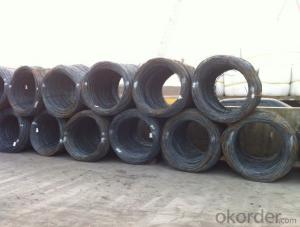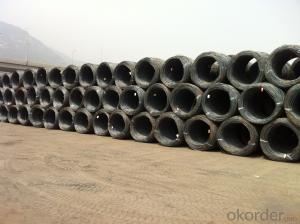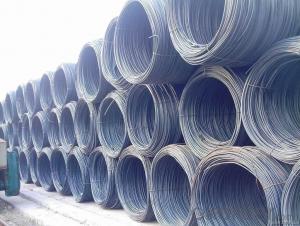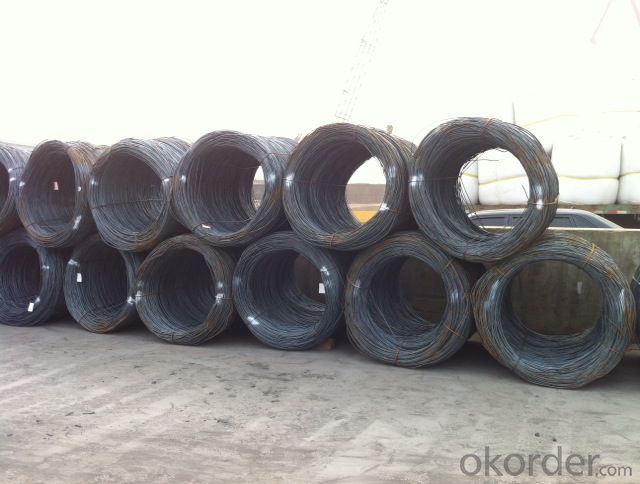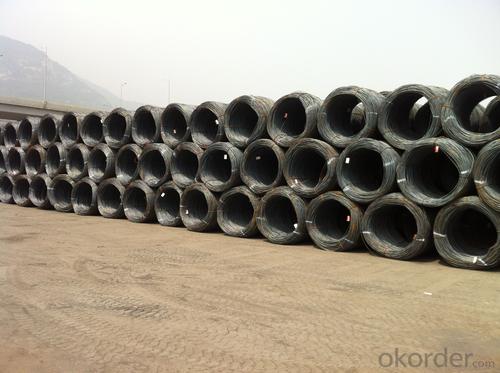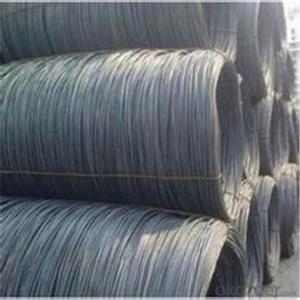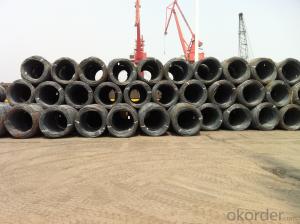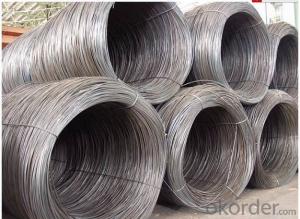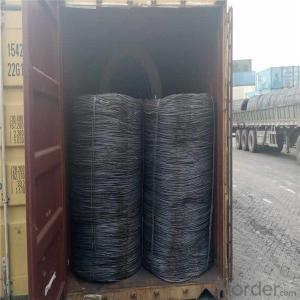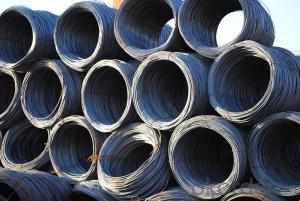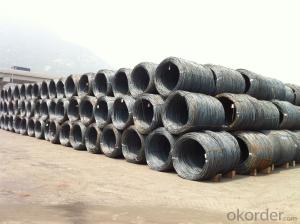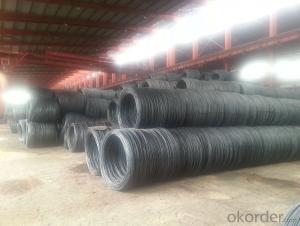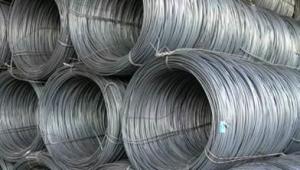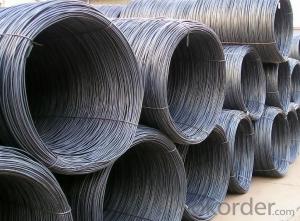ASTM SAE1006-1008 Wire Rods with Best Price and Quality
- Loading Port:
- Tianjin
- Payment Terms:
- TT OR LC
- Min Order Qty:
- 25 m.t
- Supply Capability:
- 20000 m.t/month
OKorder Service Pledge
OKorder Financial Service
You Might Also Like
Specification
OKorder is offering Hot Rolled Carbon Steel Wire Rod 5.5mm with High Quality at great prices with worldwide shipping. Our supplier is a world-class manufacturer of steel, with our products utilized the world over. OKorder annually supplies products to European, North American and Asian markets. We provide quotations within 24 hours of receiving an inquiry and guarantee competitive prices.
Product Applications:
Hot Rolled Carbon Steel Wire Rod 5.5mm with High Quality is widely used in construction and manufacturing. Carbon steel wire rod is mainly used for reinforcement of reinforced concrete and welded structure or reprocessed (roberts , nail, etc.) materials, especially used to produce wire drawing, welding electrode, nails, spring, electronic, precise machinery parts and so on.
Product Advantages:
OKorder's Hot Rolled Carbon Steel Wire Rod 5.5mm with High Quality are durable, strong.packed and suitable for wire mesh,nail manufacture and construction
Main Product Features:
· Premium quality
· Prompt delivery & seaworthy packing (30 days after receiving deposit)
· Can be recycled and reused
· Mill test certification
· Professional Service
· Competitive pricing
Product Specifications:
Manufacture: Hot rolled
Grade: SAE1006 SAE1008 SAE1010 SAE1012 SAE1016 SAE1018
Certificates: ISO, SGS, BV, CIQ
Weight per Coil:2-2.05tons
Packaging: Export packing, packed by coil
Grade | Chemical Composition (%) | |||||
C | Mn | S | P | Si | B | |
SAE1006B | 0.03~O.07 | 0.32max | 0.045max | 0.040max | 0.30max | 0.0008min |
Mechanical properties | ||||||
Yield strength(N/mm2) | Tensile strength(N/mm2) | Elongation (%) | ||||
250-280 | 350-380 | ≥32 | ||||
Grade | Chemical Composition (%) | |||||
C | Mn | S | P | Si | B | |
SAE1008B | 0.10max | 0.3~0.50 | 0.050max | 0.040 max | 0.15max | 0.0008 min |
Mechanical properties | ||||||
Yield strength(N/mm2) | Tensile strength(N/mm2) | Elongation (%) | ||||
≥195 | 315-430 | ≥30 | ||||
FAQ:
Q1: Why buy Materials & Equipment from OKorder.com?
A1: All products offered by OKorder.com are carefully selected from China's most reliable manufacturing enterprises. Through its ISO certifications, OKorder.com adheres to the highest standards and a commitment to supply chain safety and customer satisfaction.
Q2: How do we guarantee the quality of our products?
A2: We have established an advanced quality management system which conducts strict quality tests at every step, from raw materials to the final product. At the same time, we provide extensive follow-up service assurances as required.
Q3: How many tons can be loaded into one 20ft container?
A3: Around 18—20tons,9-10 coils.
Q4:What's your payment term?
A4:Mostly,we collect the money by T/T and LC at sight . We also accept time LC at 90/120 days sight.
Image:

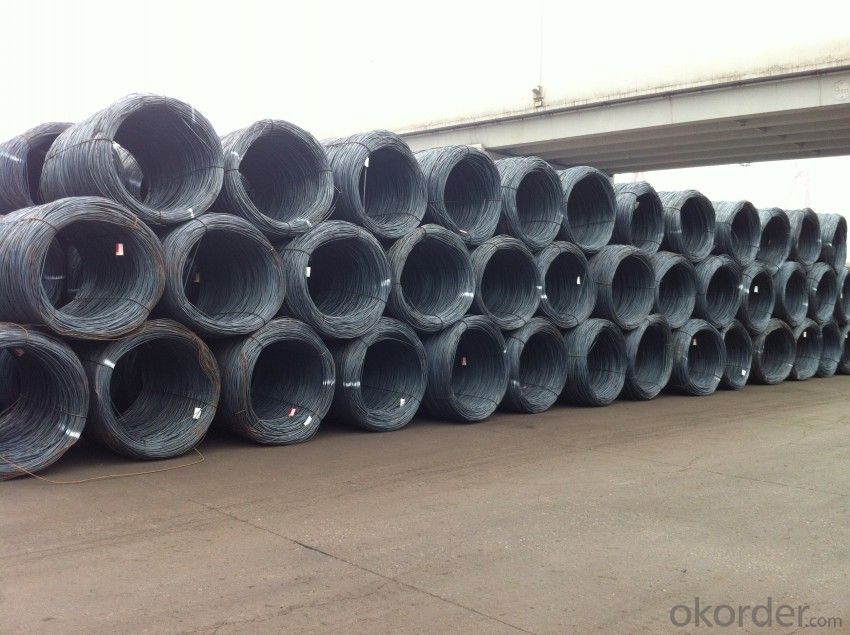
- Q: How is steel wire rod used in the manufacturing of wire baskets and containers?
- Steel wire rod is used in the manufacturing of wire baskets and containers as the primary raw material. It is first drawn through a series of dies to achieve the desired diameter and shape. This process strengthens the wire and improves its structural integrity. The wire rod is then bent, welded, or woven into the desired basket or container shape, providing a sturdy and durable framework. Additionally, the steel wire rod can be coated or galvanized to enhance its corrosion resistance, ensuring a longer lifespan for the wire baskets and containers.
- Q: What are the factors that affect the mechanical properties of steel wire rod?
- The mechanical properties of steel wire rods are influenced by several factors. 1. Composition: The chemical composition of steel, including the presence of alloying elements such as carbon, manganese, silicon, and others, determines its mechanical properties. Different compositions result in varying levels of strength, toughness, and ductility. 2. Microstructure: The microstructure of steel, including grain size and distribution, also affects its mechanical properties. Fine-grained steels generally exhibit higher strength and improved toughness compared to coarser-grained ones. Heat treatment processes can be used to control the microstructure and enhance desired properties. 3. Heat treatment: Various heat treatment processes, such as annealing, quenching, and tempering, can significantly alter the mechanical properties of steel wire rods. These processes modify the structure and hardness of the material, providing desired levels of strength, hardness, and ductility. 4. Processing conditions: The mechanical properties of steel wire rods can also be influenced by the processing conditions during manufacturing. Factors such as the temperature, rate of cooling, and deformation applied during rolling, drawing, or extrusion processes can affect the final properties. Proper control of these parameters is crucial to achieving the desired mechanical properties. 5. Surface finish: The surface condition of steel wire rods can impact their mechanical properties. A smooth and clean surface is generally preferred as it reduces the likelihood of cracks, improves fatigue resistance, and enhances overall performance. 6. Impurities and defects: The presence of impurities, such as sulfur, phosphorus, and non-metallic inclusions, can negatively impact the mechanical properties of steel wire rods. Similarly, manufacturing defects like cracks, voids, and inhomogeneities can weaken the material and reduce its strength. 7. Environmental factors: The environment in which steel wire rods are used can affect their mechanical properties. Variables such as temperature, humidity, exposure to corrosive substances, and mechanical loading conditions can all influence the material's behavior, including its strength, ductility, and corrosion resistance. In conclusion, the mechanical properties of steel wire rods are influenced by factors such as composition, microstructure, heat treatment, processing conditions, surface finish, impurities, defects, and environmental factors. Understanding and controlling these factors are crucial in producing steel wire rods with desired mechanical properties for various applications.
- Q: What is the size range of steel wire rod?
- The size range of steel wire rod can vary depending on the specific application and industry requirements. Generally, steel wire rod is available in diameters ranging from 5.5mm to 20mm. However, there can be variations beyond this range based on specific customer needs. The size range is chosen based on factors such as the intended use, strength requirements, and manufacturing capabilities. It is important to consult with steel wire rod manufacturers or suppliers to determine the appropriate size range for a particular application.
- Q: What are the main factors affecting the market policies of steel wire rod?
- The main factors affecting the market policies of steel wire rod are supply and demand dynamics, global economic conditions, trade policies and regulations, technological advancements, and competition within the industry. Additionally, factors such as raw material costs, energy prices, environmental regulations, and government policies related to infrastructure development and industrial growth also play a significant role in shaping the market policies for steel wire rod.
- Q: How are steel wire rods used in the manufacturing of wire baskets for organizing items?
- Steel wire rods are used in the manufacturing of wire baskets for organizing items as they serve as the primary material for constructing the framework and structure of the basket. The rods are bent, shaped, and welded together to create the desired size and design of the basket. This sturdy and durable wire framework provides stability and strength to the basket, allowing it to hold and organize items efficiently.
- Q: What are the common industry competencies for steel wire rod suppliers?
- Some common industry competencies for steel wire rod suppliers include expertise in metallurgy and material science, knowledge of manufacturing processes and quality control measures, understanding of customer requirements and specifications, strong supply chain management capabilities, and the ability to consistently deliver products that meet industry standards and customer expectations. Additionally, suppliers should have a solid track record of reliability, on-time delivery, and excellent customer service.
- Q: What are the common traceability requirements for steel wire rod?
- Some common traceability requirements for steel wire rod include the need to track and document the origin of the raw materials used, the manufacturing processes involved, and the final destination or customer for each batch of wire rod produced. Additionally, traceability requirements may also involve keeping records of quality testing and inspection results, as well as maintaining a comprehensive documentation system to ensure transparency and accountability throughout the supply chain.
- Q: What is the hardness range of steel wire rod?
- The hardness range of steel wire rod typically varies between 35 to 55 on the Rockwell C scale.
- Q: What are the common production processes for osmium-coated steel wire rod?
- The common production processes for osmium-coated steel wire rod include wire drawing, cleaning and degreasing, osmium coating through methods like electroplating or physical vapor deposition, and final heat treatment for improved hardness and durability.
- Q: What are the different types of steel wire rod surface cleaning methods for wire galvanizing?
- There are several different types of steel wire rod surface cleaning methods for wire galvanizing. These include mechanical cleaning methods such as brushing or shot blasting, chemical cleaning methods such as pickling or acid cleaning, and electrolytic cleaning methods. Each method has its advantages and is chosen based on the specific requirements and conditions of the galvanizing process.
Send your message to us
ASTM SAE1006-1008 Wire Rods with Best Price and Quality
- Loading Port:
- Tianjin
- Payment Terms:
- TT OR LC
- Min Order Qty:
- 25 m.t
- Supply Capability:
- 20000 m.t/month
OKorder Service Pledge
OKorder Financial Service
Similar products
Hot products
Hot Searches
Related keywords
